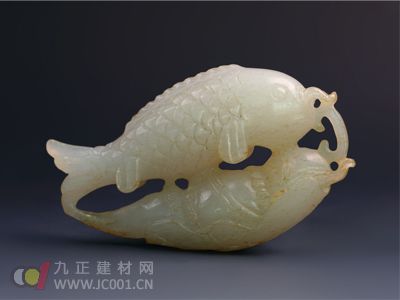1. In ancient times, a variety of jade materials were commonly used in jade artifacts, including white jade, sapphire, topaz, jasper, and nephrite. Today, many new stone and mineral materials are being used in fake products, such as counterfeit yellow topaz made from Huang Qiyan. In practice, it's crucial to distinguish between authentic jade materials and identify the differences between old and new versions of the same material.
2. Understanding the basic structural features of different jade types is essential, along with knowing their hardness, density, non-uniformity, and permeability. Once these characteristics are mastered, one can analyze how long an ancient jade artifact was buried under certain conditions, what effects this had on the material, and the oxidation and corrosion patterns that developed over time. Fake items often rely on surface effects rather than real material properties, which makes them inconsistent with natural aging processes and easily distinguishable from genuine pieces.
3. Aging is a common characteristic of real jade, but when it comes to fakes, this aging effect may be artificially created using new materials or old residues. The newly exposed surfaces after re-cutting or grinding may show significant color changes or damage the original oxide layer, making them easy to spot.
4. It's important to note that the type of jade material alone cannot determine authenticity, as the same material has been used for thousands of years. Identification should not rely solely on material analysis. If no clear difference is found, further evidence from Other aspects must be sought to confirm whether the item is genuine or fake.

5. Some low-quality, inexpensive jade-like materials are currently used for counterfeiting. These are often artificially corroded to create thick oxide layers on the surface, which are fragile and lack the natural texture of real jade. Such materials were never used in ancient times and are purely modern imitations.
6. Recognizing the artistic styles and techniques of ancient jade is vital. Each era has its own distinct design and craftsmanship. While some fakes can be identified through style, high-quality imitations are difficult to detect. In such cases, additional clues from other areas—such as texture, wear, and process details—are necessary. Folk-style jade can be very diverse, so style alone isn't a reliable indicator but can serve as a reference for visual judgment.
7. Ancient jade reflects a perfect blend of craftsmanship and artistry. However, there are often visible flaws in the process, such as mismatched shapes or flawed designs. These imperfections help distinguish real pieces from fakes, especially when compared to modern imitations that often lack the depth and character of authentic work.
8. The level of mechanization affects the quality and consistency of jade products. Over time, tools and techniques have evolved, resulting in different styles across historical periods. Understanding the characteristics of real jade allows one to identify which parts of a modern fake are incorrect in terms of technique or process. It’s also important to recognize the difference between mechanical and manual effects, as well as variations in grinding techniques and intentional errors. This helps in identifying subtle differences between real and fake craftsmanship.
Modern processing tools and abrasive materials differ significantly from traditional methods, leading to distinct grinding effects. Ancient jade was typically processed using free sand grinding, which is different from the fixed grinding methods used today. Recognizing these differences and understanding the historical techniques can help identify fakes more effectively.
9. Familiarizing oneself with modern counterfeit techniques is essential. Many fake items use advanced equipment to mimic the appearance of real jade, including light effects. By analyzing the optical properties of real jade and comparing them to fake ones, it's possible to distinguish between true and artificial brightness effects.
10. Authentic ancient jade often contains naturally colored materials, which have undergone long-term underground exposure. This leads to oxidation and corrosion in specific areas, creating a unique pattern. Fakes, on the other hand, often try to replicate this by applying artificial stains or coloring. However, the hardness, density, and color changes in fake pieces are fundamentally different from those of real jade. It's important to differentiate between real oxidation and artificial treatments, as genuine ancient jade shows clear signs of natural aging, such as color shifts, penetration, and changes in hardness.
Pot Filler,Kitchen Faucet Pot Filler,Wall Mounted Folding Faucet,Wall Mounted Kitchen Faucet
kaiping aida sanitary ware technology co.,ltd , https://www.kpaidafaucets.com